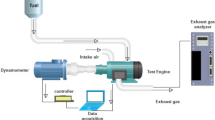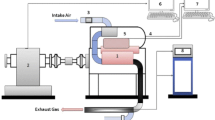Abstract
An avalanche consumption of fossil fuels has paved the way for the use of biodiesel as the alternative fuel especially in the automotive sector. In the present study, an experimental investigation was made on the potential use of palm biodiesel (PB) and tyre pyrolysis oil (TPO) as the substitute of the conventional petroleum fuels. The results show that the brake thermal efficiency at lower loads of both the fuels, i.e., PB90TPO10 and PB80TPO20, is almost equal, but at the higher loads blend having higher TPO content (PB80TPO20) results in improved brake thermal efficiency. From the brake specific consumption data, it can be concluded that higher TPO content signifies prompt and better combustion of fuel resulting in lower fuel consumption per unit power spent. The Fourier transform infrared spectroscopy of the blends has been conducted to provide an insight structural view of the blends via depicting the functional groups at different spectral peaks. So the present study demonstrates that the performance parameters and the physical properties of the fuel blends are in close confirmation with the conventional diesel and may be considered for future investigations.






Similar content being viewed by others
Abbreviations
- PB:
-
Palm Oil Biodiesel
- TPO:
-
Tyre pyrolysis oil
- PB90TPO10:
-
Blend containing 90% POB and 10% TPO by volume
- PB80TPO20:
-
Blend containing 80% POB and 20% TPO by volume
- GP:
-
Generator power (Watt)
- BP:
-
Brake power (Watt)
- TFC:
-
Total fuel consumption (kg/s)
- BSFC:
-
Brake specific fuel consumption (kg/watt-s)
- BSEC:
-
Brake specific energy consumption (kg/s)
- FIP:
-
Fuel indicated power (watt)
- η bte :
-
Brake thermal efficiency (%)
- GCV:
-
Gross calorific value (MJ/kg)
- x :
-
Weight of the fuel taken in the crucible (kg)
- y :
-
Weight of water in the calorimeter (kg)
- z :
-
Water equivalent of the calorimeter, stirrer, thermometer and bomb (kg)
- t 1 :
-
Initial temperature of water in calorimeter (°C)
- t 2 :
-
Final temperature of water in calorimeter (°C)
References
Sanderson K (2011) Lignocellulose: a chewy problem. Nature 474(7352):S12–S14
Bull TE (1999) Biomass in the energy picture. Science 285(5431):1209–1210
Gui MM, Lee KT, Bhatia S (2008) Feasibility of edible oil vs. non-edible oil vs. waste edible oil as biodiesel feedstock. Energy 33(11):1646–1653
Brakora JL, Ra Y, Reitz RD (2011) Combustion model for biodiesel-fueled engine simulations using realistic chemistry and physical properties. SAE Int J Engines 4(1):931–947
Herbinet O, Pitz WJ, Westbrook CK (2008) Detailed chemical kinetic oxidation mechanism for a biodiesel surrogate. Combust Flame 154(3):507–528
Lee AF, Bennett JA, Manayil JC, Wilson K (2014) Heterogeneous catalysis for sustainable biodiesel production via esterification and transesterification. Chem Soc Rev 43(22):7887–7916
Atadashi IM, Aroua MK, Aziz AA (2011) Biodiesel separation and purification: a review. Renew Energy 36(2):437–443
Wilson K, Lee AF (2012) Rational design of heterogeneous catalysts for biodiesel synthesis. Catal Sci Technol 2(5):884–897
Semwal S, Arora AK, Badoni RP, Tuli DK (2011) Biodiesel production using heterogeneous catalysts. Bioresour Technol 102(3):2151–2161
Zabeti M, Daud WM, Aroua MK (2009) Activity of solid catalysts for biodiesel production: a review. Fuel Process Technol 90(6):770–777
Liu Q, Wang B, Wang C, Tian Z, Qu W, Ma H, Xu R (2014) Basicities and transesterification activities of Zn–Al hydrotalcites-derived solid bases. Green Chem 16(5):2604–2613
Demirbas A (2007) Importance of biodiesel as transportation fuel. Energy Policy 35(9):4661–4670
Abu-Hamdeh NH, Alnefaie KA (2015) A comparative study of almond and palm oils as two bio-diesel fuels for diesel engine in terms of emissions and performance. Fuel 150:318–324
Yu X, Wen Z, Li H, Tu ST, Yan J (2011) Transesterification of Pistacia chinensis oil for biodiesel catalyzed by CaO–CeO2 mixed oxides. Fuel 90(5):1868–1874
Chen GY, Shan R, Shi JF, Yan BB (2015) Transesterification of palm oil to biodiesel using rice husk ash-based catalysts. Fuel Process Technol 133:8–13
Balakrishnan M, Batra VS, Hargreaves JS, Pulford ID (2011) Waste materials–catalytic opportunities: an overview of the application of large scale waste materials as resources for catalytic applications. Green Chem 13(1):16–24
Chang FW, Kuo MS, Tsay MT, Hsieh MC (2003) Hydrogenation of CO2 over nickel catalysts on rice husk ash-alumina prepared by incipient wetness impregnation. Appl Catal A 247(2):309–320
Adam F, Iqbal A (2010) The oxidation of styrene by chromium–silica heterogeneous catalyst prepared from rice husk. Chem Eng J 160(2):742–750
Liu Y, Guo Y, Zhu Y, An D, Gao W, Wang Z, Ma Y, Wang Z (2011) A sustainable route for the preparation of activated carbon and silica from rice husk ash. J Hazard Mater 186(2):1314–1319
Sarin A, Arora R, Singh NP, Sarin R, Malhotra RK, Kundu K (2009) Effect of blends of Palm-Jatropha-Pongamia biodiesels on cloud point and pour point. Energy 34(11):2016–2021
Benjumea P, Agudelo J, Agudelo A (2008) Basic properties of palm oil biodiesel–diesel blends. Fuel 87(10):2069–2075
Tat ME, Van Gerpen JH (1999) The kinematic viscosity of biodiesel and its blends with diesel fuel. J Am Oil Chem Soc 76(12):1511–1513
Ong HC, Mahlia TM, Masjuki HH, Honnery D (2012) Life cycle cost and sensitivity analysis of palm biodiesel production. Fuel 98:131–139
Buyukkaya E (2010) Effects of biodiesel on a DI diesel engine performance, emission and combustion characteristics. Fuel 89(10):3099–4105
Murugan S, Ramaswamy MC, Nagarajan G (2008) Performance, emission and combustion studies of a DI diesel engine using Distilled Tyre pyrolysis oil-diesel blends. Fuel Process Technol 89(2):152–159
Sharma SK, Das RK, Sharma A (2016) Improvement in the performance and emission characteristics of diesel engine fueled with jatropha methyl ester and tyre pyrolysis oil by addition of nano additives. J Braz Soc Mech Sci Eng 38(7):1907–1920
Author information
Authors and Affiliations
Corresponding author
Additional information
Technical Editor: Luis Fernando Figueira da Silva.
Rights and permissions
About this article
Cite this article
Das, R.K., Sharma, S.K. Fuel characterization and performance parameters analysis of diesel engine using blends of palm biodiesel and tyre pyrolysis oil. J Braz. Soc. Mech. Sci. Eng. 39, 1491–1497 (2017). https://doi.org/10.1007/s40430-016-0696-2
Received:
Accepted:
Published:
Issue Date:
DOI: https://doi.org/10.1007/s40430-016-0696-2




